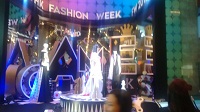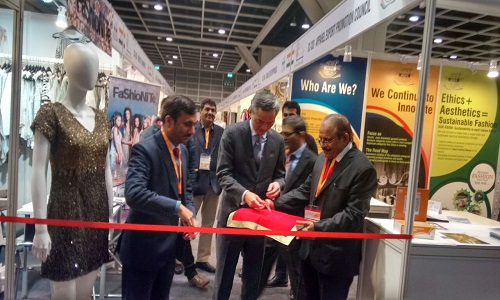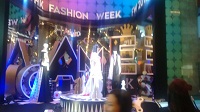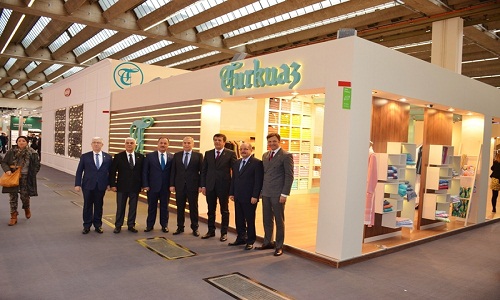FW
With a CAGR of 8.8 per cent between 2016-22, the global spandex market is expected touch $10,482 million by 2022 says the latest Spandex Fiber Market Report. Solution dry spinning segment would generate the highest revenue throughout the forecast period. In 2015, Asia-Pacific led the global market and is expected to maintain its position. The region is also expected to witness highest growth.
According to a senior analyst, Team Lead Chemical Research, Asia-Pacific is the most attractive market for the new entrants along with industry players as the growth in number of industries and increased expenditure towards R&D is expected to provide significant opportunities to the entrants. The industry players made significant investments on new commercial avenues for their product segments via strategic partnerships and collaborations.
Investments towards extensive research and development activities coupled with an increasing support for application of spandex fiber is expected to boost market growth. There is a rise in demand for spandex fiber from various end-user industries and an increase in application scope owing to its superior properties.
Also, launch of bio-based, eco-friendly spandex products by market players is expected to drive the demand for spandex fiber over the forecast period. However, a growing threat of substitution and volatility in raw material prices could hamper the market growth during the forecast period. In 2015, the apparel & clothing segment was the largest application segment. It is expected to grow at a CAGR of 8.9 per cent in terms of revenue, followed by the home furnishing and others segment. The extraordinary physio-chemical properties of spandex fiber such as elasticity, durability and abrasion resistance have increased its penetration in a wide array of application, as it results in improved performance of the end product.
As per estimates, Burkina Faso’s production of raw cotton for the 2016-17 harvest will grow by 25 per cent compared to previous harvest as favourable rainfall boosts output, the country's agriculture minister has divulged. It is a landlocked country in Africa around 274,200 sq. km in size. It is surrounded by six countries vz Mali to the north; Niger to the East; Benin to the Southeast, Togo and Ghana to the south and Ivory Coast to the southwest. Its capital is Ouagadougou.
After blaming a GM variety supplied by US seed maker Monsanto for the decline in cotton quality, the West African country's growers had reverted entirely to conventional cotton for the new crop. The 2016-17 harvest, which is expected to total 750,000 tons, was showing improved quality as well as production, minister Jacob Ouedraogo said.
Earlier, Burkina Faso's cotton producers had complained that increased levels of short fibers in their GM cotton had impacted its market value and had last April announced that they were seeking 48.3 billion CFA francs ($78 million) in compensation from Monsanto. Acknowledging changes in cotton fiber length, the seed company has argued that fiber quality is also influenced by environmental conditions and that other cotton varieties have shown length variations. The talks between Burkina's producers and Monsanto were going on, Ouedraogo added.
In celebration of its 50th anniversary, Invista's Cordura brand has entered into its first-ever collaboration with Cotton Incorporated, the research and promotion company for US cotton producers and importers. For the whole of 2017 and beyond, the two brands will work together to explore opportunities to develop a long-lasting and more durable fabric for a new generation of performance apparel.
Traditional, reliable and biodegradable cotton fibre is known for being soft, natural and comfortable. Blending cotton with performance benefits of Cordura fibre technology will add additional comfort qualities such as quick dry, long-lasting performance, durability, extra tear strength and abrasion resistance, it is said. Collaborating with Cotton Incorporated celebrates the ideology that Cordura has been working towards for the past fifty years, said Cindy McNaull, Marketing Director of global Cordura brand.
And the company would continue to honour and embrace its history of creating durable fabrics but strive to push the boundaries of how Cordura can enhance them to create cutting-edge innovations suitable for the ever-changing marketplace. The company spoke to a host of customers and came to know their needs for cotton-rich performance fabrics that last. Working together with Cotton Incorporated will allow Cordura to bring two classics together to deliver the next generation of performance to the fabric of our lives,” McNaull added.
Fabrics from the collaboration will initially be offered from several Cordura brand authorized mills including Artistic Milliners, Nishat, Chia Her and Arvind. The two companies plan to extend the collaboration with additional technology innovations in the months to come.
After the Centre and states struck a consensus on contentious issue of sharing administrative powers, the Goods and Services Tax (GST) is set to be rolled out from July 1. With this, the road is clear for the Union government to table the associated bills in the second half of the upcoming budget session of Parliament that commences from 31 January.
To be sure, there are other issues that need to be addressed. For instance, the GST council will have to also resolve the various tax slabs. At the end of the ninth GST council meeting yesterday, both sides agreed to work towards meeting the new deadline and share administrative control over small and big taxpayers in a fixed ratio.
Both, but especially the Centre, conceded some ground to generate a consensus on this long-pending issue that was threatening to derail the implementation of the singular piece of tax reform which will, for the first time, economically unify the country. The Centre had earlier targeted a rollout on April 1.
Jordan’s clothing sector has suffered a major drop in purchasing power, exports and imports. Seasonal sales and offers are not helping traders recover from the financial crisis. Sales have fallen on an average 40 per cent in markets such as Jabal Al Hussein, 50 per cent in malls and 60 per cent in the governorates.
The kingdom’s imports of garments dropped by 16 per cent in the first nine months of 2016 compared to the same period of 2015. The average shopper bought four pieces of clothing in 2016 compared with five in 2015. Taxes, customs duties, high rents, random licensing for shops and the absence of laws regulating sales and offers in the market are blamed for the sector’s losses.
Around 15 to 20 per cent of garment traders are expected to leave the market. Garment exports make up roughly 20 per cent of the country's gross domestic product. In the arid outskirts of Jordan’s cities sit a growing number of industrial parks that house garment factories churning out clothing for some of the world’s most recognisable brands like Gap, Victoria’s Secret, Hanes, Eddie Bauer, Lands’ End and Macy’s.
There are currently 75 factories producing everything from towels to T-shirts, fleeces to frilly knickers. They account for 95 per cent of the industrial workforce, and 95 per cent of apparel exports.
"The 48th Hong Kong Fashion Week for Fall/Winter, one of Asia’s a mega fashion sourcing platform opened doors yesterday (January 16) at the Hong Kong Convention and Exhibition Centre. The four-day show being held from January 16 to 19 is being organised by the Hong Kong Trade Development Council (HKTDC). It features more than 1,500 exhibitors from 21 countries, showcasing latest fashion, garment, accessories, fabrics and sewing supplies."

The 48th Hong Kong Fashion Week for Fall/Winter, one of Asia’s a mega fashion sourcing platform opened doors yesterday (January 16) at the Hong Kong Convention and Exhibition Centre. The four-day show being held from January 16 to 19 is being organised by the Hong Kong Trade Development Council (HKTDC). It features more than 1,500 exhibitors from 21 countries, showcasing latest fashion, garment, accessories, fabrics and sewing supplies. Under the theme ‘Hall of Games’, this year’s Fashion Week for Fall/Winter incorporates board game elements throughout the fairground to enhance the ambience.
With healthy living becoming a priority among consumers, the demand for sportswear and fitness clothing is on the rise. To help buyers identify relevant products and suppliers, the HKTDC has added two new zones to this year’s show: ‘Fashionable Sportswear’ and ‘Denim & Casual Wear’. The former showcases the hottest styles for various sports activities, including fitness and yoga while the latter focuses on trendy designs for a relaxed lifestyle.
Country pavilions a major attraction

There are five pavilions at the fair and India is one of the prominent ones. Other include Indonesia, Japan, Macau and Pakistan. Companies from Italy, Sweden and Pakistan are debuting this year at the fair, bringing along names such as Italian brand Salto, displaying its eco-leather silver pleated skirt; Swedish company Yves Lansac, is showcasing colourful and fashionable watch and handbag collections; and Pakistani exhibitor Umar Garments Printing, introduces its automated screen printing technology that allows high flexibility and accuracy for producing simple to complex designs with advanced inks.
As a global fashion sourcing hub, Hong Kong is a hotspot for many international trading houses and premier retailers. The annual Hong Kong Fashion Week for Fall/Winter is an important platform for buyers to discover latest fashion and accessories. To create more business opportunities for exhibitors, the HKTDC has arranged 90 buying missions from 43 countries and regions bringing more than 3,770 companies to the show. Among the participants are representatives of famous fashion labels, mega chain stores and distributors from both traditional and emerging markets, including Spain’s Beni Room, Japan’s H.P. France, Thailand’s Jaspal and the Chinese mainland’s The Fashion Door.
Fashion shows showcasing creativity
More than 20 fashion events are taking place during the four-day Hong Kong Fashion Week for Fall/Winter. In addition to trend forecasting seminars, thematic forums and networking receptions, a total of 10 fashion shows including designers’ collection and brand collection shows are being staged. Hong Kong Fashion Week has long been a launch pad for up-and-coming local young designers. To spotlight Hong Kong’s design talent, local fashion website ‘Fashionally’ presented two fashion shows on the first day featuring collections of 14 fashion labels by emerging local designers. Participants included established names as well as first-time participants, including Jane Ng, Yeung Chin, Kenson Tam, Winnie Chen and Key Chow.
Ideal platform for exchange, collaboration
To help industry players exchange and obtain market intelligence, the HKTDC has invited industry experts to share their insights and ideas on the latest trends and topics at a series of events, including trend forecasting seminars, thematic forums and networking receptions.
Leading international fashion forecaster ‘Fashion Snoops’ shared their forecast and analysis on ‘The Key Trend Stories for Men’s and Women’s Wear for S/S 2018’. The HKTDC and The Hong Kong Research Institute of Textiles and Apparel (HKRITA) will host a seminar on ‘Knitting Tech – From Materials to Finishing’. On Jaunary 18, Asian e-tailer giant Zalora will explore the latest business opportunities of Omni-Channel Retailing, while The Woolmark Company, an authority in the wool industry, will host the ‘The Wool Lab S/S 18’ seminar to discuss the leading trends for Spring/Summer 2018 and introduce purchasing guides to the best wool fabrics and yarns.
YDC now open for applications
Facilitating growth in Hong Kong’s fashion industry has always been the HKTDC’s core mission. Apart from the launch of the FASHIONALLY website and the coordination of the Fashionally Collection shows during the bi-annual Hong Kong Fashion Weeks, the HKTDC has been actively organising the Hong Kong Young Fashion Designers’ Contest (YDC) since its debut 40 years ago. The YDC is a springboard for unearthing talented local designers and this year’s competition will be held during CENTRESTAGE in September. The contest is now open for applications until 10th April.

"Heimtextil, after four successful trade fair days in Frankfurt am Main, dropped curtains in style. In spite of the snow, ice and storms, particularly on the first and last days of the trade fair, almost 70,000 trade visitors from across the world attended the leading trade fair for home and contract textiles and were won over by quality and variety of the exhibited products as well as the trends of the new season. Growth was driven primarily by Brazil, China, the UK, Italy, Japan, Russia, the US and UAE."

Heimtextil, after four successful trade fair days in Frankfurt am Main, dropped curtains in style. In spite of the snow, ice and storms, particularly on the first and last days of the trade fair, almost 70,000 trade visitors from across the world attended the leading trade fair for home and contract textiles and were won over by quality and variety of the exhibited products as well as the trends of the new season. Growth was driven primarily by Brazil, China, the UK, Italy, Japan, Russia, the US and UAE. A total of 2,963 exhibitors from 67 countries presented their new textile products and designs across 20 halls and were highly satisfied by the orders they received and business contacts they made.

Detlauf Braun, CEO, Messe Frankfurt, highlighted the positives following the end of the trade fair, “The figures speak for themselves. Heimtextil grew once again in 2017 in terms of its visitor and exhibitor numbers. But it’s no longer about quantity and hasn’t been for a long time. I am especially pleased about the high quality of the products exhibited as well as the intensity of discussions between purchasers and exhibitors. Frankfurt is the international meeting place and beating textile heart of the interiors industry.”
Andreas Klenk, CEO, Saum & Viebahn said he returned to Heimtextil at the right time: as successful positioning gave their new profile and product orientation. The feedback from visitors was positive and they were able to acquire both export and domestic contacts.
Textile Design: The eye feels too
It is not just the feel of a material that determines its appeal – something that was also obvious at Heimtextil with the great interest shown in textile design. The colourful fabrics and varied designs by well-known designers and young talent were popular and attracted a lot of attention: “For me as a designer, Heimtextil is extremely interesting, in particular because I can see myself designing bed linen, pillows and other home textiles in future in addition to wallpaper”, says star designer Michael Michalsky, who presented his new wallpaper collection at the trade fair. “At the world’s leading trade fair, competitors are present in great numbers. Here, I can experience marketing of products at close quarters and get direct feedback.” And it was not just designers that showed great interest in the globally unique design offer at Heimtextil. Exhibiting companies also used the creative hotspot to acquire new designs for their upcoming collections.
Trend towards more materiality
An end to bare walls and cold floors: home textiles celebrated their comeback in private homes. Curtains, carpets and decorative cushions are decorating people’s own four walls and lending them a personal note. “We can also confirm the trend towards more materiality. In addition to our new wallpaper products, we have seen an increased interest from visitors in our new fabric collections”, said Andreas Zimmermann, CEO, Zimmer + Rohde. This trend is boosting orders at Heimtextil, “The quality of visitors was very high. We met very high-quality, good international purchasers and excellent potential new customers. We are therefore very satisfied with our attendance at Heimtextil.”
Sleeping as a lifestyle
After nutrition and fitness, sleeping will be the next big lifestyle theme. This was proven by the numerous innovations seen in the bed segment. Mediflow from Hamburg, for example, presented an improved version of its water pillow capable of full adjustments for firmness and supportive effect. Robert Kocher, European CEO, Mediflow, said, “This year, we had lots of new customers at our stand who had heard about us and wanted to know more about our products or even ordered them directly. Visitors primarily came from the Middle East, China, the eastern European region and Scandinavia. We also enjoyed intense discussions with American and German customers. This is also the great strength of Heimtextil. It is not just about sales, but also communication and establishing relationships or simply getting direct feedback on our products”.
The next Heimtextil, international trade fair for home and contract textiles, will take place from January 9-12. 2018 in Frankfurt am Main.
"US President Trump’s ‘Make US great again’ has had significant impact on the average hourly wages of garment workers, with their wages getting a spiked 2.9 per cent from the same period last year. Owing to this, unemployment rate dropped to an 18-year low at about 4.1 per cent. Mark Zandi, Chief Economist, Moody’s Analytics, says the job market is very tight and getting tighter. Businesses are struggling to hire or hang onto people so they have no choice but to raise wages. These are people who are very skilled. It’s very difficult to hold onto those workers. The industry also has a high percentage of foreign born workers. "

US President Trump’s ‘Make US great again’ has had significant impact on the average hourly wages of garment workers, with their wages getting a spiked 2.9 per cent from the same period last year. Owing to this, unemployment rate dropped to an 18-year low at about 4.1 per cent. Mark Zandi, Chief Economist, Moody’s Analytics, says the job market is very tight and getting tighter. Businesses are struggling to hire or hang onto people so they have no choice but to raise wages. These are people who are very skilled. It’s very difficult to hold onto those workers. The industry also has a high percentage of foreign born workers. The biggest reason behind this is the immigration restriction imposed by the government, which is forcing manufacturers to pay their remaining workers even more. This is only the beginning. It’s going to get a lot worse.

Senator Tom Cotton, along with Senator David Perdue (R-GA), introduced a legislation in 2017 that would further raise Americans’ wages by reducing the current mass legal immigration levels, where more than one million mostly low-skilled legal immigrants enter the US every year, putting downward pressure on working and middle-class Americans’ wages and job opportunities. At the same time, the Act would shift the current legal immigration system from one that prioritises high-skilled, English-proficient immigrants over those with low-education rates and minor skills.
The scenario till now
According to the Bureau of Labor Statistics, over the past two decades, fashion manufacturing jobs in the US have declined by more than 80 per cent, dropping from about 900,000 jobs in 1990 to just 150,000 jobs in 2011. Just two years after the federal government enacted the North American Free Trade Agreement (NAFTA), companies laid off 706 American workers from fashion manufacturing jobs in the US, with 67,511 workers initially filing for unemployment. Between 1996 and 2011, companies laid off an average of 323 American workers every year in the fashion manufacturing industry. In that same period, American workers in textile mills suffered an average of 200 layoffs per year. In 1996, some 1,040 American workers in the clothing, textile, and leather manufacturing industry were fired from their jobs.
Every year the US admits more than 1.5 million foreign nationals, with the vast majority deriving from family-based chain migration, whereby newly naturalised citizens can bring an unlimited number of foreign relatives to the US. In 2016, the legal and illegal immigrant population reached a record high of 44 million. By 2023, the Center for Immigration Studies estimates that the legal and illegal immigrant population of the US will make up nearly 15 per cent of the entire US population.
Immigrants and low wages
For blue-collar American workers, mass immigration has not only kept wages down, but in many cases, decreased wages. Meanwhile, the US continues importing more foreign nationals against whom working-class Americans are forced to compete. In 2016, the US brought in about 1.8 million mostly low-skilled immigrants.
For white-collar American workers, mass immigration has become a tool for the big business lobby, cheap labour industry, and Silicon Valley elites to replace US citizens with cheaper foreign workers. For example, 71 per cent of tech workers in coveted high-paying, white-collar Silicon Valley jobs are foreign-born, while the tech industry in the San Francisco, Oakland, and Hayward area is made up of 50 per cent foreign-born tech workers. The growing foreign-born population dominating the workforce in Silicon Valley comes as nearly 500,000 Americans graduate in the STEM fields every year. Overall, four million young Americans enter the workforce every year, but their job opportunities are further reduced as there are roughly two new foreign workers for every four American workers who enter the workforce.
In 2015, the textile and textile products industry in Malaysia was the 10th largest export earner, contributing approximately 1.7 per cent to Malaysia’s total exports of manufactured goods. The textiles and textile products industry in Malaysia comprises four sub-sectors. These are primary textiles which cover activities such as polymerisation, spinning, weaving, knitting and wet processing; made-up garments; made-up textiles; and textile accessories.
Due to the intensified global competition, Malaysia’s textile manufacturers are moving up the value chain by diversifying into the production of higher value-added textiles, implementing automation and computerised manufacturing processes, seeking business collaboration with foreign companies to acquire new technologies and undertaking research and development activities to develop new processes, new applications and value-added products. The industry currently employs more than 68,000 workers.
The US, Japan, China, Singapore and Turkey are Malaysia’s top five export destinations. The US is the leading market for Malaysian textiles products taking 18.3 per cent of the industry’s total exports. Malaysia’s imports from Germany for the first 10 months of 2014 rose by 4.4 per cent while Malaysian exports to Germany during the same period went up by 3.9 per cent.
Malaysia is Asean’s number one exporter to Germany. The main exports include electronic and electrical products, electrical machines, printers, machinery parts and components, rubber products and optical lenses.
Honeys, the big Japanese clothing retailer that shifted production from China to Myanmar in 2012, is mulling with the idea of opening its third factory in Yangon, it is understood. The expansion of operations of Honeys in Myanmar is highlighted in a National Association of REALTORS (NAR) report on the bright outlook for the manufacturing sector as it benefits from an end to economic sanctions and low-cost labour.
Honeys, which in 2012 became the first Japanese garment manufacturer to begin production in Myanmar, makes about 18,000 pieces of clothing a day at its two Yangon factories, it was reported on January 14. It said that the factories account for about 20 percent to 30 percent of Honeys sales in Japan, one of the main destinations of garments made in Myanmar, along with South Korea and the European Union.
Since it began operating less than two years ago, the number of production lines at the second Honeys factory increased from five to 34 and its workforce from about 300 to 2,600, NAR reported. Honeys began outsourcing to China in the early 2000s but decided to shift part of its production to Myanmar because of cheaper labour. Labour costs were beginning to rise in Myanmar, which introduced a minimum daily wage in 2015, but at about K200, 000 a month were still lower than Bangladesh and Vietnam, Mr Takeshi Iguchi, Honeys head in Myanmar, informed the NAR. Cheap labour and the lifting of sanctions had contributed to rapid growth in the garment sector and the Myanmar Garment Manufacturers Association representing domestic and foreign companies, had quadrupled to about 400 members since 2015, NAR maintained.












